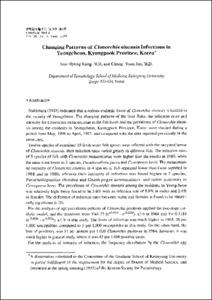Changing Patterns of Clonorchis sinensis Infections in Yeongcheon, Kyungpook Province, Korea*
- Keimyung Author(s)
- Joo, Chong Yoon
- Department
- Dept. of Medical Genetics (의학유전학)
- Journal Title
- Keimyung Medical Journal
- Issued Date
- 2000
- Volume
- 19
- Issue
- 1
- Keyword
- Clonorchis sinensis; Clonorchiasis; Yeongcheon; Kyungpook Province; Catalytic curve; Prevalence; Metacercaria; Catalytic model.
- Abstract
- Nishimura (1943) indicated that a serious endemic focus of Clonorchis sinensis is located in the vicinity of Yeongcheon. The changing patterns of the liver fluke, the infection rates and intensity for Clonorchis metacercariae in the fish hosts and the prevalence of Clonorchis sinensis among the residents in Yeongcheon, Kyungpook Province, Korea were studied during a period from May. 1996 to April, 1997, and compared with the data reported previously in the same area.
Twelve species of examined 19 fresh water fish speaes were infected with the encysted larvae of Clonorchis sinensis, their infection rates varied greatly in different fish. The infection rates of 5 species of fish with Clonorchis metacercariae were higher than the results in 1980, while the rates were lower in 2 species, Pseudorasbora parva and Coreoperca herzi. The metacercarial intensity Clonorchis sinensis in 4 species of fish appeared lower than those reported in 1968 and in 1980. whereas their intensity of infection was found higher in 2 species, Paracheilognathus rhombea and Gnathopogon atromaculatus. and rather stationary in Coreoperca herzi. The prevalence of Clonorchis sinensis among the residents in Yeongcheon was relatively high, being found to be 5.6% with an infection rate of 8.9% in males and 2.4% in females. The difference of infection rates between males and females is found to be statistically significant (t>2).
For the analysis of age prevalence patterns of Clonorchis positives applied the two-stage catalytic model, and the equations were Y=1.75 (e-0.011t - e-0.026t), a>b in 1964 and Y= 0.1316 (e-0.005t - e-0.043t), a<b in this study. The force of infection was much higher in 1964; 26 per 1.000 susceptibles, compared to 5 per 1,000 susceptibles in this study. On the other hand, the loss of positivity was 11 per annum per 1,000 Clonorchis positives in 1964, however, it was much higher in present study, where it was 43 per 1,000 positive cases.
For the analysis of intensity of infection, the frequency distribution by the Clonorchis egg counts was calculated as well as the cumulative percentage to the total number of positive cases, the regression equation in this study was Y=1.925+1.01 log X. These figures indicates that most cases of Clonorchis positives were found to be mild infections. This study indicates that clonorchiasis among residents in Yeongcheon is less prevalent than several decades ago and continues to decline.
- Keimyung Author(s)(Kor)
- 주종윤
- Publisher
- Keimyung University School of Medicine
- Citation
- 강선병 and 주종윤. (2000). Changing Patterns of Clonorchis sinensis Infections in Yeongcheon, Kyungpook Province, Korea*. Keimyung Medical Journal, 19(1), 23–46.
- Type
- Article
- Appears in Collections:
- 2. Keimyung Medical Journal (계명의대 학술지) > 2000
1. School of Medicine (의과대학) > Dept. of Medical Genetics (의학유전학)
Items in Repository are protected by copyright, with all rights reserved, unless otherwise indicated.
